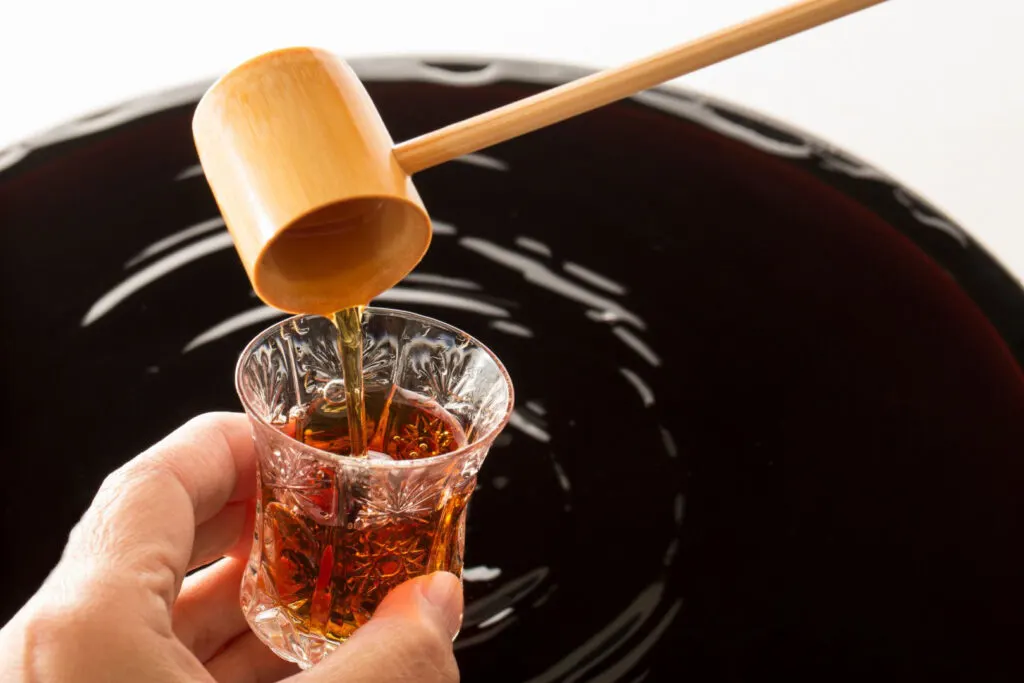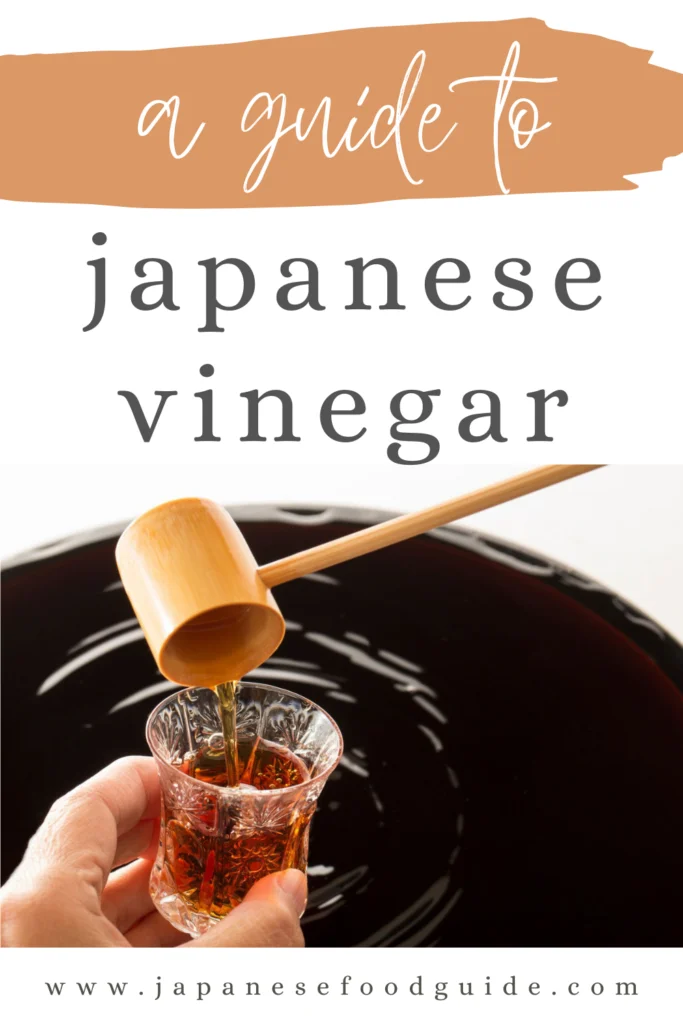Vinegar is processed in various forms in Japan and is familiar as a seasoning and flavor for cooking. Japanese vinegar or su (酢, す) is used in a wide variety of foods that give off a sour taste, from ponzu (a Japanese citrus-based condiment), mayonnaise and vinegared miso paste, to sushi rice and pickles, along with a whole host of more unexpected uses.
A seasoning that is closely related to the history of alcohol, vinegar has been familiar to mankind since ancient times. It is produced by the fermentation of alcohol using a microorganism called acetic acid bacteria. Therefore, any alcoholic beverage can be turned into vinegar, and the advent of Japanese vinegar is unsurprisingly rooted in the sake making process. We can even see the connection between the two through the shared kanji radical 酉, which depicts a partially-filled vessel of alcohol (the kanji character for sake is 酒, while vinegar is 酢).
Vinegar is generally referred to by the name of the raw material used to make it, such as grain vinegar when made from grains, and fruit vinegar when made from fruits. Around the world, vinegar is also made from corn, honey, pineapple, coconut, sugar cane and more.
This article will focus on vinegar as defined by the Food Labeling Standard as part of the Food Labeling Act (formerly under the Japanese Agricultural Standard or JAS), including the different types of Japanese vinegar and what they are used for.

Table of Contents
History of Japanese Vinegar
The world’s oldest vinegar on record is a vinegar made from dates and raisins during the ancient Babylonian Empire (Mesopotamia) around 5000 BCE.
However, the history of vinegar in Japan is said to date back to around the 3rd century CE when technology for making sake was introduced from China. It was also called karasake or karazake (辛酒, からさけ or からざけ), now an archaic term meaning bitter or “spicy” sake, because sake could turn into vinegar.
In the Nara period (710-794), there is record of vinegar being made along with sake at a government office called Mikinotsukasa (造酒司, also read as Sakenotsukasa), mentioned in the Yōrōritsuryō (養老律令), a document outlining the penal and civil codes of the time.
A further reference is made to this government office in Volume 40 of the Engishiki (延喜式, えんぎしき), a 50-volume series of books written in the 10th century containing Japanese laws and customs of the Engi period (901-923). Here we can find detailed information about how to make 10 different kinds of sake, and how vinegar along with sake and amazake was made at the Mikinotsukasa office (with a staff of 76 no less) and served to the Emperor at Heian Imperial Palace.
The Benefits of Japanese Vinegar
In Japan, vinegar is credited with numerous nutritional and health benefits. According to Japanese food producer Mizkan, it is recommended to consume at least 1 tablespoon of vinegar a day to:
3) Slow the rise in blood glucose levels after eating
For those interested in incorporating vinegar into their diet, fortunately there are many kinds of Japanese vinegars, from sweet to savory and everything in between, and an equally vast number of ways to use them.
Types of Japanese Vinegar
The Food Labeling Standard (食品表示基準, しょくひんひょうじきじゅん) defines what ingredients may go into each type of vinegar if it is to be labeled as such, and has minimum requirements for the amount of raw materials to be used per liter.
Based on the Standard, Japanese vinegar is divided into three categories:
- Brewed grain vinegar
- Brewed fruit vinegar
- Synthetic vinegars
The first two are collectively known as Jōzō-su (醸造酢, じょうぞうす) or brewed vinegars, while synthetic vinegars are called Gōsei-su (合成酢, ごうせいす) and represent vinegars that use glacial acetic acid or acetic acid diluted with water and flavored with sweeteners.
In addition, we will introduce some vinegars that are also commonly referred to as su (vinegar) in Japan that are actually not classed as vinegar as per the official Standard.
1. Grain Vinegar
Grain vinegar includes rice vinegar and vinegar made from other kinds of grains, such as barley, wheat and maize.
The Food Labeling Standard categorizes them as:
- Rice vinegar (米酢, こめず or よねず)
- Black vinegar (rice) (米黒酢, こめくろず)
- Black vinegar (barley) (大麦黒酢, おおむぎくろず)
- Other grain vinegars must be labeled as “grain vinegar” (穀物酢, こくもつず)
Regular rice vinegars are used for dishes where a lighter-colored vinegar is preferred, such as for Sunomono (酢の物), a vinegared side dish typically made with cucumber and wakame seaweed, and Sanbaizu (三杯酢), a simple liquid seasoning containing a mixture of vinegar, sugar and soy sauce that is commonly used for marinades and dressings.

Black rice vinegar (黒酢, kurozu), a fermented and matured vinegar using brown rice, is also a popularly available Japanese vinegar. Kurozu black vinegar is frequently used in Chinese dishes, and stir-fried or deep-fried dishes. Chain restaurant Ootoya has many Kurozu black vinegar dishes on their menu, such as this chicken and vegetable black vinegar set (鶏と野菜の黒酢あん定食, tori to yasai no kurozuan teishoku).
In Japan, there are many black vinegar products available on the market. Since black vinegar has mild umami compared with regular rice vinegar, people like to use black vinegar to make dressings and dipping sauces, and you’ll also see lots of black vinegar based drinks.

2. Fruit Vinegar
Fruit vinegar is further divided into three categories:
- Apple vinegar (りんご酢, りんごす)
- Grape vinegar (ぶとう酢, ぶとうす)
- And other ‘fruit vinegars’ (果実酢, かじつす)
There are some well-known fruit vinegars that fall into this ‘other’ category, such as kakizu made from persimmons in Wakayama Prefecture (Kansai region) and in the southern region of Kyushu, both production areas of persimmons. Both sweet and astringent persimmons can be processed into vinegar if they have sufficient sugar content.

Fruit vinegar is most often used in drinks rather than in dishes, although it is sometimes used in fancy dressings for salad. Uchibori Jōzō run by the Uchibori family, with one of the brothers the world’s first and only vinegar equivalent of a sommelier (cleverly referred to as ‘sumerie’ combining ‘su’, the Japanese word for vinegar, and the Japanese pronunciation of sommelier), has an amazing fruits vinegar selection with more than 100 different kinds under their Oaks Heart brand.
Uchibori Jōzō is a unique Japanese vinegar producer in that it ferments acetic acid bacteria into the juice they make the fruit vinegar with. It takes more time and effort to make it using real fermentation rather than simply adding fruit juice to the final product, and is a healthier alternative because it doesn’t use any preservatives or artificial flavors, relying on the natural flavor and sweetness of the fruits.
Uchibori has reimagined the uses for Japanese vinegar, taking it from traditional cooking to being served more unexpectedly as a cocktail or dessert, or in combination with yoghurt and milk. At the Oaks Heart Osuya store and stand-up vinegar bar, appropriately named “Expre-su”, on B3 level of Ginza’s Mitsukoshi department store in Tokyo, you can buy a range of fruit-based dessert vinegar products, like blueberry vinegar, Uchibori’s first dessert vinegar launched in 2003, which works well mixed with milk for a pleasantly tangy morning pick-me-up.

Ways to enjoy Japanese dessert vinegar as a beverage
Uchibori provides three simple recipes for enjoying Japanese dessert vinegar at home.
1. With water, sparkling water, milk or soy milk
Add 15ml of dessert vinegar to a glass of water, sparkling water, milk or soy milk.
2. With hot water
Enjoy vinegar at tea time by adding 15ml of dessert vinegar to 60ml of hot water.
3. With beer
Add 20ml of dessert vinegar to 180ml of beer and mix well with a muddler.
For those who like to make desserts at home, Uchibori also says fruit vinegar can be added into fresh cream as a hack to make it whip faster. Dessert vinegar also works well as a topping over ice cream.
3. Other Japanese Vinegars
Besides grain and fruit derived vinegars, other types of Japanese vinegar include Kibi vinegar made from sugarcane (kibizu, きび酢, きびず) and Hachimitsu vinegar (hachimitsusu/hachimitsuzu, はちみつ酢) made from honey.
Another vinegar that is unique to Japan is Akazu (赤酢, あかず), also known as Kasuzu (粕酢, かすず), made from sake kasu or sake lees. It was popular as a sushi vinegar during the Edo period (1603-1868) with many Edomae-sushi restaurants using it. It is red-brown-ish in color, and compared to grain vinegar is not so sour, has more umami and is more nutritious with more than twice the amount of amino acids than rice vinegar.
The sake kasu is fermented for more than two years and then it takes another three years to make this vinegar. According to Japanese food producer Mizkan, the first Akazu was made by their founder, Matazaemon Nakano, who believed he could make sushi taste even better with sake lees vinegar over regular rice vinegar.
The Aichi-based company launched their premium sake lees vinegar called ‘Yamabuki’ in 1845 and was well-received in the sushi world, with the company even claiming it helped spur the growing popularity of sushi in the capital Edo (modern-day Tokyo), where large shipments would flow from their headquarters in the coastal city of Handa, south of Nagoya.
You can learn more about Mizkan’s history as a vinegar manufacturer in Japan and the role of vinegar in Japanese cuisine, as well as purchase Yamabuki and other products at the Mizkan Museum, opposite its corporate office in Handa.
4. Unique Japanese vinegars that aren’t actually vinegar
Other vinegars unique to Japan that don’t use acetic acid bacteria and aren’t labeled as vinegars as per the Food Labeling Standard, but are still generally referred to as su (酢), include Moromizu (もろみ酢, もろみず) and Umezu (梅酢, うめず).
Moromizu, a Japanese vinegar from Okinawa Prefecture produced with citric acid, is made from the distilled lees leftover when Awamori (a distilled alcohol indigenous to Okinawa) is made. While Umezu is a Japanese vinegar made from pickled plum, which has a strong salty taste.

Have you ever tried Japanese vinegar? What kind would you most like to try?
Pin me for later

Kyoko Nagano is a serial entrepreneur and Michelin star restaurant enthusiast based in Kanagawa. As a Certified sake sommelier, fermented food sommelier, and tofu, inarizushi and soy oil meister, she is an expert on Japanese food and drink.
Kyoko has spent 17 years abroad in 4 countries, and is now on a mission in Japan to support small craft sake breweries and traditional cultural businesses to help them survive.
